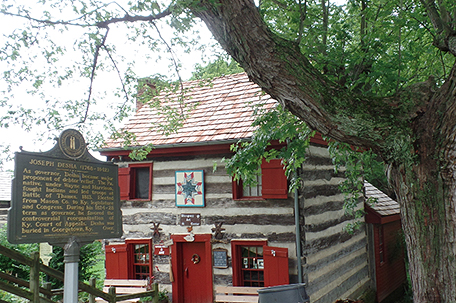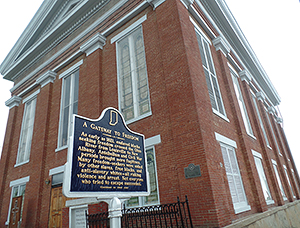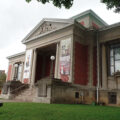
ABOVE PHOTO: Desha House
By Renée S. Gordon
“You may remember, as I well do, that from Louisville to the mouth of the Ohio, there were, on board, ten or a dozen slaves,
shackled together with irons. That sight was a continual torment to me; and I see something like it every time I touch the Ohio, or any other slave-border.” –A. Lincoln to Joshua Speed, August 24, 1855
The first documented runaways absconded from Connecticut and Massachusetts in 1690 and 15 years later, in1705, records indicate the first slave to seek freedom in Canada.
It is estimated that the Kentucky Underground Railroad routes crossing the Ohio River were the busiest of the nation’s routes and the shore in front of Louisville is believed to be the most often used section of the river. White members of society supported the Louisville UGRR “Liberty Line”, as well as abolitionists, African American sailors, porters, teamsters, stevedores and three African American communities: Clarksville, Jeffersonville and New Albany.
This loose association of interracial and interdenominational Individuals crossed all gender and age lines to function in three basic capacities: field agents, stationmasters and conductors.
Agents were those people who collected information and conveyed it to freedom seekers and other UGRR workers. Stationmasters provided safe haven and hid, fed, clothed, and passed fugitives along to the next stop. Conductors accompanied the escapees. Every person at every point along the route was in danger of losing their life, liberty, and in the case of free black and white accomplices, their fortune and livelihood. In spite of these dangers, slaves always fled.
Ironically, just as Kentucky had the busiest UGRR line it was also one of the country’s busiest and most lucrative slave trading and breeding centers. Initially, most Kentucky slaves were sold regionally. But in 1833, a law was passed prohibiting the importation of slaves into the state for resale. Without additional slave labor, profits dropped and the cost of individual slaves rose so precipitously that the law was repealed in 1849. Louisville became a slave center with more than 50 slave traders and a stream of coffles being moved along the roads and rivers further south. Estimates say that between 2000 to 4000 slaves were sold annually. By 1861, Louisville was the 12th largest city in the country and slaves made up 7.8 percent of the population (4,914) with 25 percent of them hired out to work. More than 28,000 Kentucky slaves enlisted in the United States Colored Troops. Slavery ended in the state on December 18, 1865. gotolouisville.com
A marker has been placed at Second and Main, on the site of Matthew Garrison’s slave pen. Garrison was the region’s largest slave trader and he had a reputation for disregarding whether the black person had been previously enslaved.
A portion of Indiana, directly across the Ohio from Louisville, is considered part of the Louisville metropolitan area and as such is entwined in the history of the city. Research points to the fact that anti-slavery activity began at the turn of the 19th-century and by 1810 abolitionists managed to rescind major pro-slavery territorial legislation. Upon admission to the Union six years later, the state constitution prohibited slavery.
With the Polly v. Lasselle ruling in 1820 the Indiana Supreme Court emancipated all the slaves residing in the State and the following year a Supreme Court ruling banned indentured servitude. Abraham Lincoln’s family moved to Indiana in 1816 and he lived there for the next 14-years. He was undoubtedly influenced by growing up, he left at 21, in the “Borderlands.”
New Albany, Indiana was founded by three brothers in 1813, after they purchased 822.5-acres for $8,000, and laid out the city on high ground on the Ohio River. New Albany, named after the capital of New York, quickly became Indiana’s largest city and an important shipping and steam boat building center. The city’s Downtown Historic District consists of more than 40 Neo-Classical, Greek Revival and Italianate buildings, many located along Main Street. There are six additional historic districts. sunnysideoflouisville.org
Because of the proximity to the Ohio River, the maritime industry and free black community New Albany provided tremendous support to the Underground Railroad at all levels. Two churches, Town Clock Church and Bethel African Methodist Episcopal Church, stand today as monuments to New Albany’s UGRR participation. cityofnewalbany.com
Bishop Paul Quinn founded Bethel African Methodist Episcopal Church in 1840. Bethel was active in the UGRR and suffered damage as a result of their stance. The current congregation worships in a former Methodist church.
The Town Clock Church was constructed as Second Presbyterian Church of brick in the Georgian style with a 160-foot clocktower that could be seen from the Ohio River. The structure functioned as an UGRR station with the complicity of the white congregation and there is speculation that it was designed to serve that purpose. African Americans were members of the church and were both baptized and married there.
One of the most famous UGRR conductors, Levi Coffin, is known as the “President of the UGRR” and is credited with assisting more than 2,000 fugitives over a 20-year period. During the time Levi and Catherine Coffin were stationmasters in Fountain City, Indiana not a single slave failed to reach freedom.
Major routes from Kentucky led to the Coffin home which has been designated a National Historic Landmark and is open for tours. indianamuseum.org/explore/levi-coffin-house
The most notable of the escapes associated with the Coffins is that of Eliza Harris, made famous in the book “Uncle Tom’s Cabin”. She fled her Dover, Kentucky owner along with her youngest child in the winter of 1830. Upon reaching the shore of the frozen Ohio River, hearing the sounds of pursuit, she jumped onto the ice. She proceeded to jump from ice floe to ice floe until she reached the opposite shore and eventually the relative safety of the Coffin depot before moving north to Ontario, Canada.
Maysville and the nearby Washington, Kentucky relate the story of the UGRR in the Borderlands in a comprehensive and understandable way through a blend of museums, artifacts, walking tours and informational state historic signage. The 110-mile drive from Louisville to Maysville is scenic and gives visitors an opportunity to see the historic rock fences along Paris Pike. In the 1800s, the fences were constructed by Irish immigrants for plantation owners. A widening of the road at the turn of the 21st-century included an effort to preserve the fences. Craftsmen were imported to complete the task at a cost of more than $7-million per mile.
Limestone settlement was established at the juncture of Limestone Creek and the Ohio River in the 1780’s and seven years later the town of Maysville was founded by Daniel Boone and Simon Kenton. It was named for John May, a surveyor and signer of the Declaration of Independence.
In 1848, it became the Mason County Seat. Maysville prospered as an exporter of hemp and wrought iron and once housed one of the largest tobacco warehouses in the world. The city retains much of the architecture of an antebellum river town and the Historic District includes more than 150 structures. cityofmaysville.com
In 1998, Maysville began the Floodwall Mural Project, the history of the city pictured in a series of Panels showcasing important events including a Shawnee bison hunt, the 1825 visit of Lafayette and one dedicated to hometown star Rosemary Clooney. An Underground Railroad Mural portrays symbols that represent various aspects of a fugitive’s journey. Also pictured is the John Rankin House located opposite the city across the Ohio River.
Maysville is believed to have been one of the UGRR’s most traveled crossing points and so it is fitting that the first national museum in the country dedicated to chronicling, studying and celebrating the UGRR. The museum recounts African American history through the lens of slavery and abolition. National Underground Railroad Museum tours are educational and docent-led.
The museum dates from 1994 but since 2006 has been situated inside the 1837 Federal Bierbower House, a documented UGRR station. The three-story house has a place for hiding slaves on the lower level. The Bierbowers moved to Kentucky from Pennsylvania and were the owners of five slaves.
One of the sons was a commander of the 124th Colored Infantry during the Civil War. Three galleries on the first floor display exhibits of posters, photographs, artifacts and documents, many donated by area residents. The History Channel and by Smithsonian Magazine have featured the house.
The second mayor of the city, William Phillips, began constructing, using enslaved labor, what would become the largest home in Maysville in 1825. Before the Greek revival, 12-room, six-bedroom, house was completed Phillips ran out of money and the structure became known as “Phillips’ Folly.”
Phillips disappeared, but returned in 1831 with enough money to complete the house. The house had two slave pens on the lower level capable of holding up to 300 slaves being transported down river. Francis Armstrong an UGRR conductor later owned the house and secreted fugitive slaves there. The house is said to be haunted and has been featured on “Ghost Adventures”.
Adjacent to Phillips’ Folly is the Pioneer Graveyard the oldest cemetery in Maysville. Many of the city’s earliest residents are interred here including Peter Grant, the abolitionist uncle of President Ulysses S. Grant.
Simon Kenton founded Washington, Kentucky, four miles from Maysville, on his fifth trip to the area in 1775. He recruited families to join him and in 1786 a stockade was constructed. By the end of the 1700s, it was the second largest city in the state, with more than 110 log cabins and the first in the nation to be named in honor of George Washington. It became the county seat in 1788 and remained so until it was moved to Maysville.
Today, Old Washington Historic District offers a variety of thematic tours of this unique site. The Underground Railroad Tour includes visits to five sites including the Harriet Beecher Stowe Slavery to Freedom Museum. The tour is an easy walk, lasts from 45 to 60-minutes and is seasonal or by appointment. Old Washington also has the only surviving log cabin post office in the US. washingtonky.com
James Paxton was a lawyer and abolitionist who constructed the Paxton Inn in 1810. The inn functioned as both a meeting place for local members of the community and slave traders and as a station on the UGRR. A hidden stairway between the first and second floors was used to secure fugitives until they could safely cross the Ohio. Paxton, his spouse and four children lived in a home adjacent to the inn.
A Methodist congregation formed here in 1786 and the 1848 Old Church Museum, Methodist Episcopal Church South, is the second on site. Slaves were seated in a loft accessed by an exterior ladder. Once they were seated the ladder was removed to prevent escape. The loft has since been removed.
The 1787 Mefford’s Fort is the only known remaining flatboat house. The Mefford’s and their 13 children rafted down the Ohio aboard the boat and then used the planks to construct the house.
Harriet Beecher visited a former student in Washington in 1833. While visiting, she attended the slave auction that would alter American history. The auction was held a short distance from the home she was visiting and at that time many people considered it a form of entertainment. Beecher was appalled and in 1852 included a description of the scene in “Uncle Tom’s Cabin”. Also on this visit, she heard stories and met individuals that would shape her storyline. Topsy is based on a slave named Jane who later married Isham Anderson and lived in Washington and Eliza crossed the ice at Dover, Kentucky, a mere 10-miles from Washington.
The Harriet Beecher Stowe Slavery to Freedom Museum is located inside the 1807 Marshall Key Home she visited in 1833. The house is a brick Georgian structure with a Federal interior showcasing period furniture, a winding staircase and original doors, mantels and woodwork. The museum displays artifacts and historic editions of her novel. Exhibits were completely remounted in 2012.
On auction days crowds would gather at the Old Slave Market on the Courthouse Lawn to watch slave sales take place. The 50’ X 23’ Old Washington Courthouse was constructed in the 1794 and was destroyed by lightning in 1909. Visitors can stand on the courthouse lawn where Harriet Beecher Stowe witnessed the 1833 slave sale. masoncountykentucky.com
Visiting Maysville and Washington is like emerging into the 19th-century from a time capsule and all the information you need to enhance your journey are available online at the websites shown.
I wish you smooth travels!

















Leave a Comment